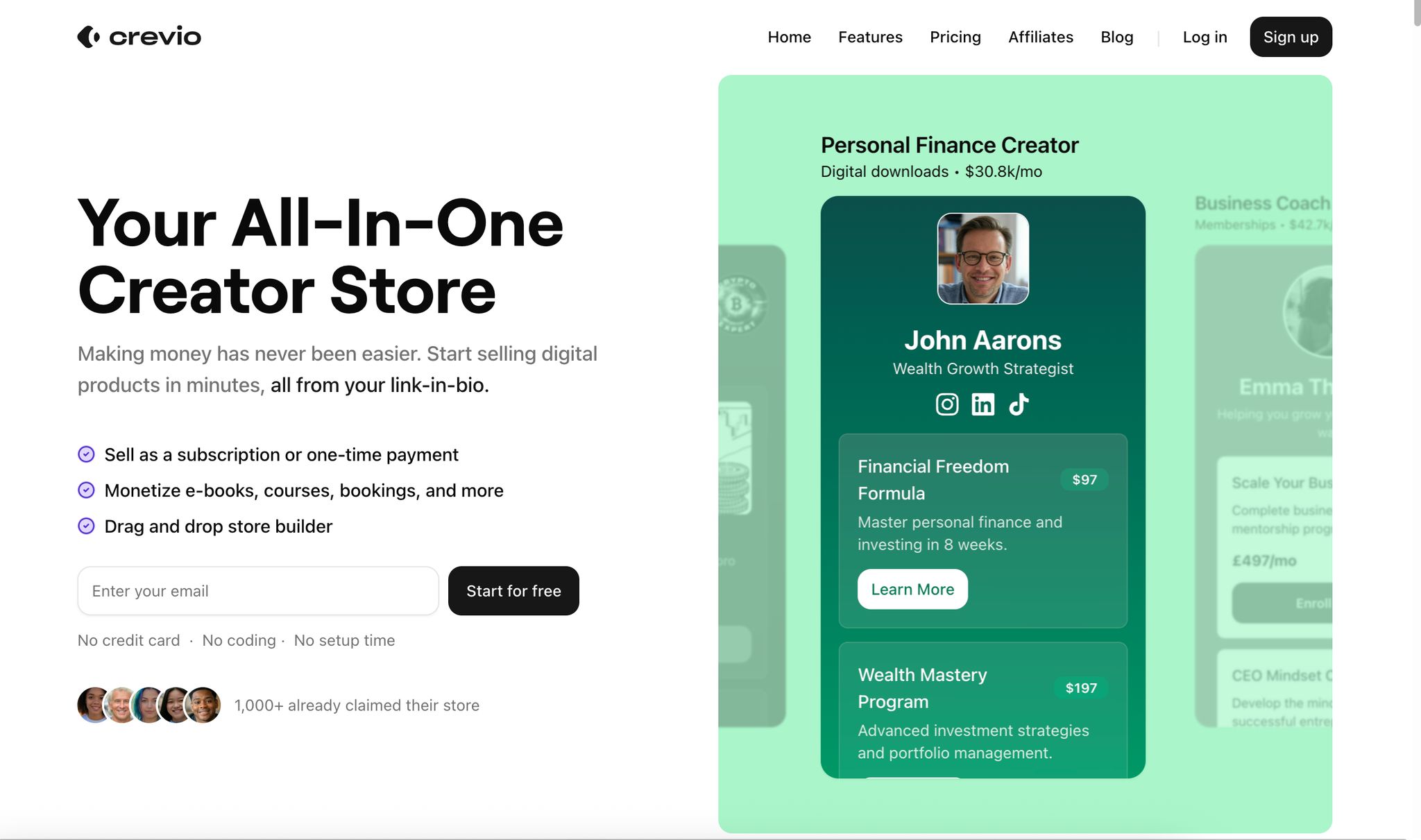10 Profitable Digital Products To Sell Online (+Real Examples)

Selling digital products online offers a scalable way to earn income with minimal overhead. Here are 10 profitable digital product ideas you can start selling today:
- eBooks and PDF Guides: Create high-quality, niche-focused content that solves specific problems. Example: Chris Greene’s Fiverr guide sells for $29.99.
- Video Courses: Teach skills or knowledge through structured lessons. Example: Miss Excel generated six-figure income by teaching Excel.
- Templates and Printables: Design tools like planners, social media kits, or presentation decks. Example: Canva templates sold via platforms like Etsy.
- Photos and Digital Artwork: Sell stock photos, illustrations, or exclusive artwork. Example: Stocksy offers 50% royalties to creators.
- Apps and Software Tools: Develop apps or plugins that solve real problems. Use subscription or freemium models for steady income.
- Sound and Music Files: Create sound effects, music tracks, or custom compositions. Example: Royalty-free sound packs for video creators.
- Video Downloads: Offer tutorials, workshops, or niche video content. Example: Cake painting videos by Eumicakes.
- Monthly Access Plans: Build subscription models for exclusive content or communities. Example: The Template Tribe charges $49/month for Canva templates.
- Website Themes and Graphics: Sell customizable themes or UI kits for platforms like WordPress or Shopify.
- Crevio Platform: Use tools like Crevio to sell and manage digital products with ease.
Quick Comparison Table
| Digital Product Type | Revenue Potential | Example/Platform |
|---|---|---|
| eBooks & PDF Guides | $20–$50 per sale | Amazon KDP, Sellfy |
| Video Courses | $197–$2,000+ | Teachable, Thinkific |
| Templates & Printables | $5–$50+ | Etsy, Creative Market |
| Photos & Digital Artwork | $10–$100+ per file | Adobe Stock, Stocksy |
| Apps & Software Tools | $10–$100/month | SaaS, App Stores |
| Sound & Music Files | $12/month or $100+ | Track Club, Artlist |
| Video Downloads | $35–$165+ | Gumroad, Sellfy |
| Monthly Access Plans | $25–$100+ per month | Patreon, Crevio |
| Website Themes & Graphics | $14–$100+ | Creative Market, Envato |
| Crevio Platform | $29–$89/month | Crevio |
Selling digital products is an excellent way to turn your skills into income. Start by identifying your expertise, validating your idea, and choosing the right platform to sell your products.
1. eBooks and PDF Guides
eBooks and PDF guides are among the most popular digital products, offering creators a scalable way to earn income. In 2020, global ebook sales accounted for 19% of total book revenue, with 191 million units sold. These numbers highlight the strong demand and earning potential for creators.
To succeed, focus on creating high-quality content and choosing the right distribution channels. Selling directly through your own website lets you keep all profits, while platforms like Amazon – holding 68% of the market share – can significantly expand your audience. Many creators use both approaches to maximize reach and revenue.
Success Stories
Take inspiration from creators like Chris Greene, whose guide, "How To Make A FULL-TIME Income With FIVERR!", sells for $29.99 and has helped users build six- to seven-figure Fiverr businesses. Similarly, Remotive’s "Finding Your Dream Remote Job", priced at $30, has been sold in 23 countries since its launch.
These examples show the importance of choosing platforms that enhance your visibility and sales. Here’s a comparison of popular platforms:
| Platform | Starting Price | Key Feature | Commission Structure |
|---|---|---|---|
| Sellfy | $19/month | Zero transaction fees | No commission |
| Payhip | Free | All-in-one solution | 5% transaction fee |
| Amazon KDP | Free | Largest marketplace | 35-70% royalty |
| SendOwl | $15/month | Supports up to 30 products | No commission |
Marketing Strategies
Selling an ebook isn’t just about writing – it’s about smart marketing. Here are some strategies to help your ebook stand out:
- Social Media Engagement: Share posts and updates related to your ebook’s topic to connect with your audience.
- Email Marketing: Build a subscriber list and use it to promote your ebook directly.
- Limited-Time Offers: Create urgency by running special promotions or discounts.
- Encourage Reviews: Ask readers to leave reviews on platforms like Amazon to build credibility.
"Effective marketing is crucial for your ebook’s success, and with the right strategies, you can significantly increase its visibility and sales." – Andrea
Finally, offering a free chapter or excerpt is a great way to attract readers and generate interest in your ebook.
2. Video Courses
Video courses are a great way to share your expertise on a larger scale while generating income. To succeed, your content must address specific problems and offer real solutions.
Course Creation Strategy
Building a profitable video course takes careful planning. You need to align your skills with what people are looking for. The most successful courses usually follow a clear structure:
| Course Component | Purpose | Implementation |
|---|---|---|
| Learning Outcomes | Set student goals | Create clear, measurable objectives |
| Content Structure | Organize material | Use modules and step-by-step lessons |
| Delivery Method | Keep students engaged | Combine video, text, and interactive tools |
| Support System | Help students succeed | Offer community access or office hours |
| Pricing Strategy | Boost revenue | Use tiered pricing based on value |
These elements form the backbone of a course that delivers results.
Success Stories
Kat Norton, also known as Miss Excel, is a standout example. She started by sharing short Excel tutorials on TikTok, which led to a course business that has helped over 17,000 students and generated six-figure revenue.
Tiffany Aliche, better known as The Budgetnista, found her niche in financial education for women. By addressing their specific needs, she built a seven-figure business and improved the financial literacy of over 2 million women.
Pricing Strategies
Here’s a simple pricing guide:
- Short self-study courses: $197 to $497
- Premium courses with added support: $2,000+
"If you start at the beginning, you just go down a rabbit hole… Instead, look at the end result that you want to achieve, and focus on how you’re helping your students to transform." – George Pitts
Production Tips
A professional setup can make a huge difference. Kevin Shen’s Dream Studio Course is a great example. His course, priced at $1,200, teaches creators how to improve their video presence with better studio setups, lighting, and audio.
"I like to think of delivering your course like putting together a sitcom episode… Use lots of relevant and fun examples in your delivery and change slides and/or camera angles often. The former will keep the content interesting and the latter will re-engage the brain of your student." – Samantha King
These small adjustments can make your course more engaging and impactful.
Marketing Your Course
Video marketing is a powerful tool for course creators. It can:
- Generate 66% more qualified leads annually
- Increase revenue growth by 49% compared to non-video users
- Keep viewers engaged, with YouTube’s average session for educational content exceeding 40 minutes
Focus on YouTube SEO and marketing automation to boost visibility and turn viewers into buyers. For instance, Liz Germain has used strategic marketing to help her students earn significant income through affiliate sales and larger audiences.
3. Templates and Printable Files
Templates and printable files combine creative design with practical applications, making them a popular choice for business professionals, educators, and entrepreneurs. They also offer a scalable way to generate revenue.
Popular Template Categories
Here are some of the most sought-after template types:
| Template Type | Target Audience | Common Uses |
|---|---|---|
| Presentation Decks | Course Creators, Coaches | Webinars, Sales Pitches |
| Brand Kits | Small Businesses | Marketing Materials, Letterheads |
| Social Media Packages | Content Creators | Instagram Posts, Stories |
| Planners & Journals | Productivity Enthusiasts | Daily Planning, Goal Setting |
| Workbooks | Educators, Coaches | Online Courses, Workshops |
Design Best Practices
To create templates that sell, focus on these key elements:
- Audience-Centric Design: Tailor templates to specific needs. For example, webinar slide decks can include pre-designed layouts for key points and bonus offers.
- Technical Specifications: Ensure templates meet standard sizes, like 8.5" x 11" for brand kits, to avoid printing issues.
- Quality and Customization: Keep designs clean and versatile. Avoid cluttered layouts to make customization easier.
Platform Economics
Knowing the fee structures of selling platforms helps you maximize profits. Here’s a quick breakdown:
| Platform | Transaction Fee | Additional Costs |
|---|---|---|
| Etsy | 6.5% | $0.20 listing fee, plus 4% + $0.30 payment processing fee |
| Creative Market | 50% | No additional fees |
| Gumroad | 10% | $0.50 per direct sale |
| Fungies | 5% | $0.50 per sale |
Marketing Strategy
Boost your sales with these strategies:
- Add seasonal options, like "2024 planner templates."
- Offer bundles tailored to specific industries.
- Include multiple color schemes or layouts for flexibility.
- Provide detailed documentation to guide users in customizing the templates.
Keep reading to learn how visual products like photos and digital artwork can expand your digital offerings.
4. Photos and Digital Artwork
The world of digital art and photography is booming. In 2023, online art-related sales reached nearly $12 billion. This surge offers creators plenty of ways to earn money from their visual content.
Key Visual Trends
Here are some popular themes shaping the market:
- Representation of diverse communities
- Climate change and environmental topics
- Seasonal imagery
- Nostalgic 90s-inspired aesthetics with bold colors
- Empowering portrayals of older adults
- LGBTQ+ inclusive visuals
"Images that are not representative of everyone and that preserve the status quo are problematic because they perpetuate the inequalities of society." – Forum One
Platform Economics
Different platforms offer varying commission structures. Here’s a quick look:
| Platform | Commission Structure |
|---|---|
| Stocksy | 50% (standard license), 75% (extended license) |
| Adobe Stock | 33% royalties |
| Saatchi Art | 60% to artist |
| ArtPal | 100% to artist |
| iStock | 15–45% based on agreement |
Creating Marketable Content
If you want your visual content to sell, focus on these areas:
- Technical Quality
Your images should look professional. Pay attention to composition, leave space for text overlays, and ensure consistent quality across your portfolio. - Authentic Representation
Showcase real, diverse experiences.
"Where are the mixed-ethnicity, same-sex couples? Where are the real moments of what their life looks like when they aren’t perfectly posed in front of the camera?" – Ryan McCoy, Shutterstock portfolio reviewer
- Market Awareness
Keep an eye on trends like popular color schemes and emerging aesthetics. Understanding what’s in demand helps you stay ahead.
Protection Strategies
Safeguard your work with these steps:
- Use watermarks
- Share low-resolution previews
- Set clear licensing terms
- Request upfront payment for high-resolution files
Marketing Tips
To stand out, build a strong online presence:
- Use relevant keywords to optimize your metadata
- Create themed collections and maintain a polished portfolio
- Focus on specific niches to target your audience effectively
"Always remember that this is a digital marketplace, not an art gallery. This is the single most important piece of advice I can give you for selling photos online." – Creative Market
With these strategies, you’ll be ready to position your visual content for success. Up next, explore how apps and software tools can take your digital offerings to the next level.
5. Apps and Software Tools
The app and software market is a major source of income, especially with over 316.2 million smartphone users in the U.S. as of 2024. Below, we’ll break down revenue models and key practices that can lead to successful software development.
Revenue Models That Work
There are several ways to make money from software products:
| Model | Best For | Benefits |
|---|---|---|
| One-time Purchase | Small utilities, plugins | Quick revenue, lower ongoing costs |
| Subscription | Complex tools, SaaS | Steady income, supports regular updates |
| Freemium | Growth-focused products | Attracts users, creates upsell potential |
Development Best Practices
To build software that stands out, focus on these areas:
- Address Real Issues: Target specific problems industries face.
- Prioritize Quality: Keep updates consistent and fix bugs promptly.
- Streamline Usability: Make interfaces simple and intuitive.
- Provide Documentation: Offer clear, easy-to-follow guides.
- Deliver Support: Be responsive to user questions and issues.
Marketing Your Software
Promote your software effectively by leveraging multiple strategies:
- Create engaging demo videos.
- Highlight customer success stories.
- Offer step-by-step tutorials.
- Participate in relevant online communities.
- Use content marketing to attract potential users.
"Keeping software updated and providing great customer support builds loyal customers and achieves long-term success."
Staying Competitive
The software world changes fast. To stay ahead:
- Add AI features where they make sense.
- Use feedback and data to improve your product.
- Keep updates regular and meaningful.
- Build systems that can scale as demand grows.
- Follow strict security standards.
Most successful software starts small and evolves based on user needs. Focus on consistent value and adapt to shifts in technology and user expectations.
6. Sound and Music Files
The digital audio market offers strong earning potential with scalable products like sound effects and music licensing. This industry caters to a wide range of needs, from game developers to advertisers.
Revenue Opportunities
The audio market can be divided into three main categories:
- Sound Effects Packs: These are one-time purchases popular with game developers and video creators.
- Music Libraries: Subscription-based services for content creators and advertisers, often starting at around $12 per month.
- Custom Sound Design: High-end services for commercial projects, with fees ranging from hundreds to thousands of dollars.
Creating Professional Audio Products
Producing high-quality audio requires meeting specific technical standards. Use standard formats like WAV (16-bit, 44.1 kHz) and ensure MP3s are mastered at 320 kbps. Include detailed metadata using the Universal Category System (UCS) to improve discoverability. Professional cover art and preview clips are essential for showcasing your work effectively.
Licensing Strategies
Music and sound licensing can significantly impact how your work is used and remembered. Research shows that 90% of ads with strong musical associations are more likely to stick with viewers. Here are common licensing models:
- Royalty-Free Licensing: A one-time purchase for unlimited use.
- Rights-Managed Licensing: Terms based on specific usage and timeframes.
- Commercial Licensing: Custom agreements tailored to business needs.
These models help you structure your licensing approach for better distribution.
Distribution Best Practices
To maximize your reach and appeal, focus on the following:
- Curate themed audio collections with clear, optimized file names and metadata.
- Provide easy-to-understand usage documentation.
- Offer high-quality preview samples to potential buyers.
- Stick to a consistent release schedule to keep your audience engaged.
"Licensing music for your commercial project is a legal solution that allows you to engage your audience on a deeper level while making sure artists are getting compensated for their original work." – Track Club
Marketplace Success Stories
Many creators have found success through effective distribution channels. Composer Zara Simon-Ogan shared her experience: "I think Sellfy does a really great job with making the purchasing process straightforward. The user experience is so effortless that it’s easy to get a high conversion rate."
Protection and Rights Management
Working with organizations like ASCAP, BMI, and SESAC can help you manage copyright registration, licensing, royalty collection, usage tracking, and even resolve disputes. These partnerships ensure your rights are protected while streamlining the administrative process.
7. Video Downloads
Video downloads have become a reliable way for creators to earn income. In 2024, online videos accounted for over 83% of all internet traffic, and the market is projected to grow by 20.7% by 2028. Plus, with more than 80% of users regularly searching for instructional videos, there’s a clear demand for tailored content in niche areas.
Popular Video Categories
Certain types of video content consistently perform well online. For example:
- Former science teacher Eunice (Eumicakes) shares cake painting tutorials.
- Guitarist Thomas McRocklin offers lessons through his online store.
- Ron Jones combines fitness and mental health techniques in his workout series.
- HAIR2U organizes videos by hairstyle for easy navigation.
In the film space, Nils Jansons and Kaspars Alksnis released their documentary Mind Your Step using a pay-what-you-want model, donating 10% of profits to WWF.
Pricing Guidelines
If you’re selling video content, here’s what research suggests about pricing:
| Product Type | Price Range | Notes |
|---|---|---|
| Single Videos | $100–$165 | Average price: $135 |
| Bundle Collections | $35–$55 | Includes 1.5–5× the content volume |
| Workshop Sessions | $67+ | Ideal for specialized training |
What You’ll Need to Get Started
Creating professional video content involves a few key steps:
- Technical Quality
- Record in high resolution with good lighting and sound.
- Ensure consistent quality across all videos.
- Content Organization
- Structure videos so they’re easy to follow.
- Include clear navigation and any necessary supplementary materials.
- Distribution Setup
- Choose secure hosting platforms.
- Monitor performance through analytics.
"I love being able to share my knowledge and my skills with others – I think that’s my purpose. And, I love that I’m able to do what I love and spend time with my family. That has always been my dream."
– Eunice, Cake Painting Video Creator
How to Monetize Your Videos
There are several ways to earn from video downloads:
- Direct Downloads: Sell videos as one-time purchases.
- Subscriptions: Charge recurring fees for ongoing content access.
- Bundles: Add value by including extras like guides or templates.
Guitar instructor Dann Mumm, for instance, packages his video tutorials with PDF tab books and Guitar Pro tabs, adding extra value for his audience.
Current Trends in Video Content
These monetization strategies align with how people consume video today. On average, U.S. residents spend over 5 hours per week watching videos on their mobile devices. Additionally, 90% of Generation Z is willing to pay for exclusive content. Since the COVID-19 pandemic, interest in spiritual and self-help videos has also grown significantly.
8. Monthly Access Plans
The subscription e-commerce market is expected to grow at an annual rate of 72.9% through 2028. This booming market offers creators a chance to establish steady income streams. Below are strategies to make subscription models work effectively.
Popular Revenue Models
Different niches have seen success with these subscription types:
| Subscription Type | Monthly Price Range | Typical Features |
|---|---|---|
| Content Access | $25–49 | Access to a digital content library with updates |
| Premium Community | $49–99 | Exclusive content and community perks |
| VIP Experience | $100+ | Private coaching and mastermind groups |
For example, The Template Tribe charges $49/month, giving members access to thousands of Canva templates and new designs based on user feedback. Subscriptions like these create dependable revenue streams when structured thoughtfully.
Keeping Subscribers Engaged
Retaining subscribers is key to long-term success. Saskia "Sassy" Gregson-Williams from Naturally Sassy uses a smart approach: she shares free content on social media to attract new members, provides consistent value through monthly video updates, and reinvests subscription revenue into creating even more free content. This creates a self-sustaining cycle of growth.
Boosting Subscriber Value
Research highlights the importance of retention:
- Retaining customers is 5–25× cheaper than acquiring new ones.
- A 5% increase in retention can raise profits by 25%.
- U.S. consumers spend an average of $273 per month on subscriptions.
"Today’s subscribers demand trust, transparency, and rich benefits. We’re focusing on clear communication of subscription terms – explicit renewal policies, and the freedom to cancel anytime."
– Adam Lifshitz, Senior Product Director of Subscriptions at Condé Nast
Tracking Success
Key metrics to monitor include Monthly Recurring Revenue (MRR), Average Revenue Per User (ARPU), Churn Rate, and Customer Lifetime Value (CLV). Companies that adjust pricing every six months often see nearly double the ARPU compared to those that make changes annually.
Practical Tips for Implementation
Here’s how to improve your subscription model:
- Offer flexible payment options
- Communicate your value clearly
- Provide regular new content
- Build an engaged community
- Keep billing practices transparent
Subscription transactions typically bring in more revenue over time. For instance, while the average one-time purchase is $108, a $38 monthly subscription can generate more income in just three months.
Advanced Retention Techniques
Jane improved her retention rate from 10% to 16% by:
- Personalizing the cancellation process
- Addressing specific reasons for cancellations
- Offering consultation calls to assist struggling users
These strategies show how a well-managed subscription model can lead to long-term profitability.
9. Website Themes and Graphics
Website themes and graphics are a major source of income for designers, with platforms like Creative Market hosting over 91,000 templates.
Market Overview
The market for website themes covers various platforms and price ranges:
| Platform Type | Price Range | Common Features |
|---|---|---|
| WordPress/Shopify | $14–$100 | Full site templates, customizable sections |
| Landing Pages | $2–$40 | Single-page designs, conversion-focused |
| UI Graphics | $1–$20 | Icons, buttons, and interface elements |
Design Platforms and Tools
Designers rely on tools like Webflow and Canva Pro to create professional themes and graphics. Webflow uses AI to apply existing design systems to new pages. Canva Pro, priced at $13/month, includes AI-powered features like Magic Write and Magic Edit for improved graphic creation.
Revenue Optimization
- Platform Diversification: Expand offerings across platforms like WordPress, Shopify, and Wix to meet diverse market needs.
- Tiered Licensing: Offer multiple licensing options to cater to different user needs:
License Type Typical Usage Price Multiplier Personal Single site Base price Commercial Multiple sites 2–3× base price Extended Commercial Unlimited use 5× base price - Stay on Trend: Popular designs include minimalist layouts, modern typography, and niche-specific templates for industries like coaching and digital products. Templates with flexible customization and platform-specific optimizations are also in demand.
Development Best Practices
To create successful templates, focus on flexibility without compromising design quality. Ensure templates are mobile-friendly, work across browsers, are easy to customize, and come with clear documentation.
Distribution Strategy
Top theme creators reach their audience through multiple distribution channels, ensuring they connect with different customer segments.
Next, learn how Crevio can support your digital product journey.
10. Crevio
 Crevio is a platform designed to help creators sell digital products while maintaining full control over their brand. Launched in 2023, it combines all the tools creators need to boost their digital income in one place.
Crevio is a platform designed to help creators sell digital products while maintaining full control over their brand. Launched in 2023, it combines all the tools creators need to boost their digital income in one place.
Platform Features
Crevio simplifies the process of selling digital products by offering a unified dashboard with the following features:
| Feature Category | Capabilities | Benefits |
|---|---|---|
| Product Types | eBooks, courses, templates, memberships | Multiple ways to earn revenue |
| Payment Options | One-time payments, subscriptions | Flexible income options |
| Store Customization | Mobile-optimized storefront, custom domains | Professional online presence |
| Content Delivery | Member’s panel, automated access | Hassle-free customer experience |
Pricing Structure
Crevio offers two subscription plans designed to match different needs:
- Basic Plan ($29/month):
- No platform transaction fees
- Support for up to 5 products
- Mobile-ready store
- 5 admin seats
- Growth Plan ($89/month):
- Unlimited products
- Priority customer support
- Custom domain integration
- Option to remove branding
These plans are designed to simplify daily operations for creators while offering flexibility as their businesses grow.
Content Management
Crevio’s member panel centralizes all digital products, making it easy to manage and deliver content. It also integrates with platforms like Discord and Telegram to help creators build and engage with their communities. The system supports various content formats, ensuring smooth delivery to customers.
Marketing Tools
The platform includes built-in marketing and analytics tools to help creators track performance and improve their strategies. Features like customer data ownership, an analytics dashboard, and customizable storefronts give creators the insights they need to grow.
User Experience
Crevio’s design prioritizes ease of use without sacrificing functionality. Creator John Sandy commented on the platform’s balance, highlighting how it combines simplicity with flexibility.
Support Resources
Creators can rely on Crevio’s 24/7 support through live chat, email, and detailed documentation to resolve any issues quickly.
Next Steps
Now that you’ve explored profitable digital product categories, it’s time to map out your next steps to turn ideas into results.
Understanding Your Market
Dive into your market using tools like Google Trends and keyword research. These tools help you identify trends and position your products effectively in a competitive digital space.
Choosing the Right Products
Pick products with strong revenue potential. For instance, ebooks often sell for around $20, while online courses can bring in $500–$1,000 per sale. Focus on what aligns with your expertise and appeals to your audience.
Validating Your Idea
Before launching, test your idea using these methods:
| Validation Method | Purpose | Expected Outcome |
|---|---|---|
| Free Coaching Calls | Understand customer needs | Direct insights into pain points |
| Competitor Analysis | Spot market opportunities | Define a unique selling point |
| Audience Surveys | Gauge interest and demand | Prioritize features and offerings |
These steps help refine your product and streamline the creation process.
Building a Strong Foundation
Engage directly with your audience to build organic growth.
"Get direct feedback! You might be surprised by the amount of digital product ideas you can receive. So, go ahead and ask your followers about the kind of product they want you to sell, and then provide it." – Sellfy Tip
Implementation Steps
- Research: Identify gaps in the market and interact with potential customers.
- Development: Create solutions that match both your expertise and your audience’s needs.
- Platform Selection: Choose a platform that offers:
- Payment processing options
- Content delivery features
- Marketing tools
- Analytics and tracking capabilities
Once your foundation is in place, you’re ready to launch and grow.
Growing Your Business
With your platform set up, focus on scaling your efforts through a well-planned growth strategy.
"Teachable has enabled us to have an incredible impact on the lives of over 60,000 students (and generate millions in revenue) in just a few short years"
Tracking Success
Keep an eye on these key metrics to measure your progress:
- Customer satisfaction
- Course completion rates (if applicable)
- Revenue per product
- Customer acquisition costs
- Refund rates



